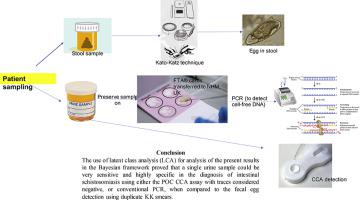Parasitology International ( IF 1.9 ) Pub Date : 2020-10-01 , DOI: 10.1016/j.parint.2020.102201 Radwa Galal Diab 1 , Mona Mohamed Tolba 2 , Rasha Abdelmawla Ghazala 3 , Ghada Ahmed Abu-Sheasha 4 , Bonnie L Webster 5 , Rasha Fadly Mady 1

|
Intestinal schistosomiasis, one of the neglected tropical diseases whose control depends on accurate diagnosis of the disease prevalence. The use of low sensitive Kato Katz (KK) fecal egg detection method as a reference gold standard is not an accurate indication especially in low transmission areas. Latent class analysis frameworks especially the Bayesian could be used instead to compare between different diagnostic tests without the use of a gold standard method as a reference. Thus, this study compared two urine-based tests for the detection of circulating antigen and cell free DNA of Schistosoma mansoni versus KK method using the Bayesian latent class analytical framework and in two models where the trace results of point of contact - assay of circulating cathodic antigen (POC-CCA) were once estimated as positive, and as negative in the other model. The Bayesian framework in the trace CCA positive model showed an estimate of disease prevalence of 26% (95% BCI:0 to 60%). POC-CCA showed the highest sensitivity (74% with BCI: 9 to 91%) and lowest specificity for (20% with BCI: 0% to 37%) and the reverse for KK. For POC-CCA with traces considered negative, it was found that results between the three tests were moderated where the positivity for infection by Schistosoma antigen detection and PCR for cell free DNA approached that estimated by the Bayesian framework (44%), and the specificity for point of contact assay(81%; 95%BCI: 59% to 100%) rose in hand with its sensitivity(77%, 95% BCI:53% to 100%) and with results for PCR test (sensitivity = 80%; 95% BCI: 61% to 100%, specificity = 69%; 95% BIC: 47% to 100%). KK remains with the highest specificity while its sensitivity in the two models never exceeded 22%. Thus, we conclude that the use of a single urine sample could be very sensitive and highly specific in the diagnosis of intestinal schistosomiasis using either the trace negative model of point of contact assay, or conventional PCR, when compared to the fecal egg detection using duplicate KK. However, the use of a single tool restricts the management of the disease in areas of low endemicity.
中文翻译:

肠道血吸虫病:尿液样本可以决定感染吗?
肠道血吸虫病是一种被忽视的热带病,其控制取决于对疾病患病率的准确诊断。使用低灵敏度的Kato Katz(KK)粪便卵检测方法作为参考金标准并不是准确的指示,尤其是在低透射率地区。可以使用潜在类分析框架(尤其是贝叶斯分析框架)来比较不同的诊断测试,而无需使用金标准方法作为参考。因此,本研究比较了两种基于尿液的检测,用于检测曼氏血吸虫的循环抗原和无细胞DNA相对于使用贝叶斯潜在类分析框架的KK方法,以及在两个模型中,接触点的痕量结果-循环阴极抗原(POC-CCA)分析的模型曾经被估计为阳性,而在另一个模型中则为阴性。痕量CCA阳性模型中的贝叶斯框架显示疾病患病率估计为26%(95%BCI:0至60%)。POC-CCA的敏感性最高(BCI为74%:9至91%),特异性最低(BCI为20%:0%至37%),而KK则相反。对于痕量被认为是阴性的POC-CCA,发现在三个测试之间的结果是适度的,其中血吸虫感染的阳性无细胞DNA的抗原检测和PCR接近贝叶斯框架估计的(44%),接触点测定的特异性(81%; 95%BCI:59%至100%)随其敏感性而提高(77 %,95%BCI:53%至100%)和PCR测试的结果(灵敏度= 80%; 95%BCI:61%至100%,特异性= 69%; 95%BIC:47%至100%)。KK仍具有最高的特异性,而在两个模型中其敏感性从未超过22%。因此,我们得出结论,与使用重复检测的粪卵检测法相比,使用接触点测定法的痕量阴性模型或常规PCR在诊断肠道血吸虫病中使用单个尿液样品可能非常敏感且具有高度特异性。 KK。但是,使用单个工具限制了在低流行地区的疾病控制。


























 京公网安备 11010802027423号
京公网安备 11010802027423号